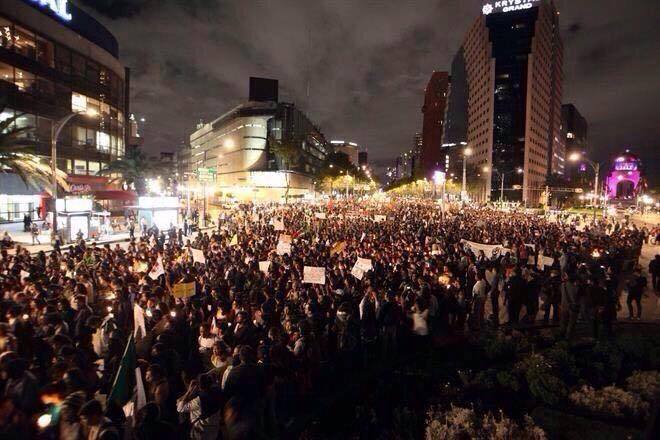 Crowds gather to demand answers in the disappearance of students.
Crowds gather to demand answers in the disappearance of students.
#TodosSomosAyotzinapa (We all are Ayotzinapa)
The biggest protest in the 21st Century in Mexico
By Luz Rodea S.
On September 26, students from the Ayotzinapa Rural College for Teachers, located in a small town located in the state of Guerrero, México, were attacked in the city of Iguala by municipal police, while they were on their way to a demonstration against the major of that locality. During the assault, 6 of the students were shot to death and 57 were held hostage, according to witnesses. A few days later, only 14 of them had been located. Since then, no one has heard from the rest, and from that day there has been no sign of the 43 missing students.
Rural Colleges for Teachers are institutions in which future educators are formed and prepared to teach children in communities that are often suffering from poverty or extreme poverty. The Ayotzinapa Rural College for Teachers, additionally, has a long tradition in political activity (and awareness) and from its classrooms were born some of the best-known characters in social justice movements.
Those 43 students were all farm boys with few options available beyond working on the fields or migrating to America. Boys who prefer being enrolled as local teachers in a school with historic radicalism and the possibility of a stable job in the future. The College, which is centered around a Marxist-Leninist ideology, was founded in 1926 with the aim of educating a peasant offspring. This same school educated Lucio Cabañas, one of the most important leaders in the Mexican guerrilla of the 70’s.
40 years later, students were soliciting money in order to attend a demonstration rejecting cuts to the school’s budget, which is state-financed. Historically, previous demonstrations had been violent, and this time was no exception. Students had demonstrated over the past years through demands concerning the state of their facilities, scholarships (in one of the poorest regions of the country) and academic improvement. They had blocked roads, stolen buses and closed buildings when authorities did not responded to their petitions.
The last violent protest occurred on December 12, 2011, a day on which students marched on the “Sun superhighway” to demand that the state governor fulfill a series of agreements that had been already settled by both parties. The riot ended in a violent eviction with guns fired. That day, two students died.
What happened on September 26 was just the tip of the iceberg of what has been happening in Mexico throughout the past decade; just days after the raid, during the search for the bodies – headed by parents and neighbors from Ayotzinapa - mass graves started to emerge with corpses which originally were thought to be the students. This information was confirmed false a couple days later. As of this writing, at least 14 mass graves have been found full of unidentified bodies, with no known history and no identity. Possibly, the victims of drug cartels and their henchmen – presumably, public servants.
Under “They took them alive, we want them back alive” motto, several protests have been held during the past few days all over the country in which different associations, universities and civilians have clamored for an answer: to have the students back, to know where they are. Perhaps the biggest demonstration happened last Wednesday, October 22, named “Global Action Day for Ayotzinapa”. The day had more than 100 protests and demonstrations all over Mexico and around the world; at least 40 universities shut down, 11 marches and sit-ins were held in 12 Mexican states and cities like Los Angeles and Chicago, in the US; Edmonton and Montreal, in Canada; Barcelona and Madrid, in Spain; London, UK; Bogotá, Colombia; Buenos Aires, Argentina; Río de Janeiro, Brazil; Munich, Germany; Vienna, Austria; Naples, Italy; and Paris, France, among others, with people claiming that we all are Ayotzinapa.
In Mexico City, the main universities had a 48-hour shutdown and students as well as academics went onto the streets to block and walk through Reforma Avenue, one of the most important streets on the city, to get to the city’s Main Square during a 4 kilometer, 4 hour march. Approximately 50,000 people attended, making it the biggest protest in Mexico in this century. “Will I be next?” “Where are they?” “It was not drug cartels, it was the State” “They wanted to bury them not knowing they would seed” were a few of the many things we heard and read during the demonstration, led by the parents of the 43 missing.
Finally, last-minute news confirmed that the spouse of the major of Ayotzinapa is one of the leaders of an organized crime group. This is the only proof needed to show that Mexico suffers not only a deep State Crisis, but also a society-rising discontent, mainly amongst its youth.
Luz Rodea S.
Born and bred in Mx city, gender specialist, urban development enthusiast, working in community development.
Catch up with me @luz_rodeas.

